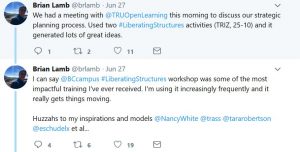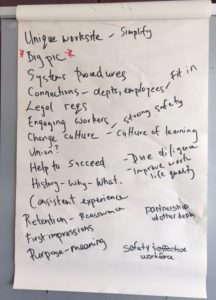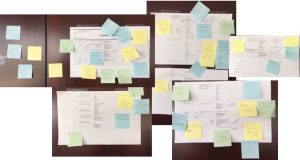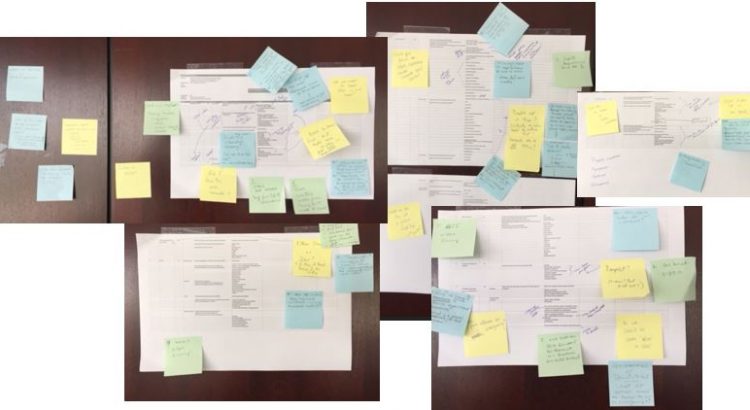There is a lot to be done at my workplace. We are building/ rebuilding a learning and training unit from the ground up. That means when it comes to gathering data, building databases, figuring out who needs what kinds of training and education as well as how to best build and deliver it, we have some gaps. And I have a list of priorities that need to be addressed.
So a few weeks ago when one of our instructors took the opportunity in a team meeting to strongly express their frustration with the new hire orientation and I found myself agreeing to dedicate our precious meeting day to fixing what (from my point of view) was one of our non-priorities, all I could think was: Ugh.
whats and whos
Before the day long meeting, we did some things to prep: gathered feedback from recent students and mapped the current content. I’m sure I had a grander prep plan, but all those with all those other priorities the time passed quickly. A few team members approached me to express some concern about this meeting and how it might unfold. Yup. I knew at the core of it all were two big questions that needed answers:
- What is the purpose of this new hire orientation?
- Who decides what good learning looks like?
Ugh.
The day before the meeting, the team started to ask good questions: Should they bring anything? Prepare something? Shouldn’t our courses be based on best practice rather than who could advocate most loudly or dig their heels in most firmly?
I said that I had lots of books at home relating to learning theory and good practice related to learning and that maybe I’d bring some of those in… I went home that afternoon envisioning how this day was going to unfold: I saw the issues and each of us clinging to and advocate for our own beloved ideas and then got into the weeds and slowly sunk into the muck… Ugh.
hows and whys
How do I keep us out of the muck? I had recently led an event with this team regarding our retraining processes using Lean value stream mapping tools that had gone pretty well. I thought about why it had worked. How? Why? At just about that moment, I happened upon a tweet:

I revisited the liberating structures site. Looking through the activities, I focused on the hows and whys of the event, ultimately settling on two: 9 whys to set the tone for the day and TRIZ to develop guiding design principles. Suddenly I had an agenda:
- Review successes from last event: Progress on lean action plan
- Why does new hire orientation matter? 9 Whys
- Look at current state agenda and define issues (with sticky notes à la Lean)
- What would the worst possible new hire experience look like? TRIZ
- Develop a future state curriculum map (again à la Lean)
How it went
Overall it went well and looked something like this:
Progress on previous lean action plan
The feedback on our progress was good. 26 actions completed and 8 more in progress. I shared a celebratory GIF… (someday maybe I’ll get it to embed here properly).
Why does new hire orientation matter?
Hooray!!!! and… back to work. We looked at first the whys.

And then we talked about some hows both for the day and for new hire
- agree / gain consistency
- get excited – have fun!
- balance customization & standardization
- use people’s previous connections/ experiences
- organize the new hire around 2-3 main areas rather than current 9 courses
- think about the balance between legal requirements (how deep is deep enough?) & fun
Look at current state agenda and identify issues
Each sticky note represents a different issue. (Yes, we identified a lot of them).

What would the worst possible new hire experience look like?
We came up with a good list and everyone participated, although one person clearly expressed not liking this activity.
- lots of war stories
- not answer questions/ dismiss concerns
- make students a number
- no engagement / no collaboration/ no talking
- Power point slides x 1,000,000
- not tell them where or when the class is
- no connection with the real world
- all expert level theory/ overly technical
- no consistency/ no structure or plan
- provide half truths and incorrect information
- no prep time for instructors
- incorrect assessment questions/ no alignment with class info
- really long/ lots of repetition
- learning in the middle of the night
And yes, when we reviewed this list again we did identify some aspects of these things in our current new hire.
Develop a future state curriculum map
Based on all of this information, we then developed a revised four module, 2-day agenda that focused on:
- No power point slides
- Limited duplication
- Lots of activity
That EVERYONE IN THE ROOM AGREED WITH.
We still have some skeptics. Will we be able to fit it all in? What kinds of logistical issues will arise? When are we going to have time to develop it? What do we do in the meantime?
Leading with the whys and hows
I have and will continue to reflect on how and why these approaches seem to work. In some ways it’s complex and I’m sure I’ll spend plenty of time in those complexities when I take up my doctoral course work again in a few weeks. But in other ways it seems simple: We can often agree on the how and why and once those are sorted out, the who and what “just” fall into place.
I will have more to say, but at this point I just wanted to capture what really was a good day without ughs.
(insert another celebretory gif here) 🙂

Thanks for sharing this story! I have shared it on to the Liberating Structures community (on a Slack instance — holler if you are not a member and want to join and I’ll send an invite via email.). It is stories of LS in use that do more for spreading LS than anything I can think of. They embody the importance of JUST DOING it, then reflecting in order to take it deeper. Keith McCandless just wrote about the Iceberg of LS — you might find it interesting https://medium.com/@keithmccandless/liberating-structures-iceberg-fac5186e2a65
Thanks Nancy. I’ll follow up via email to join the Slack instance. I am in the initial stages of formulating my doctoral thesis proposal which I think will be about change, its small humble beginnings and yes! the importance of JUST DOING. I’ll definitely look into Keith’s writing. Thanks again!